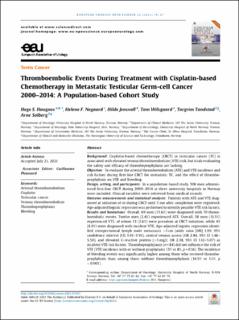| dc.contributor.author | Haugnes, Hege S. | |
| dc.contributor.author | Negaard, Helene F. | |
| dc.contributor.author | Negaard, Helene Francisca Stigter | |
| dc.contributor.author | Jensvoll, Hilde | |
| dc.contributor.author | Wilsgaard, Tom | |
| dc.contributor.author | Tandstad, Torgrim | |
| dc.contributor.author | Solberg, Arne | |
| dc.date.accessioned | 2021-09-03T11:55:17Z | |
| dc.date.available | 2021-09-03T11:55:17Z | |
| dc.date.created | 2021-08-30T17:49:44Z | |
| dc.date.issued | 2021 | |
| dc.identifier.citation | European Urology Open Science. 2021, 32 19-27. | en_US |
| dc.identifier.issn | 2666-1691 | |
| dc.identifier.uri | https://hdl.handle.net/11250/2772875 | |
| dc.description.abstract | Background Cisplatin-based chemotherapy (CBCT) in testicular cancer (TC) is associated with elevated venous thromboembolism (VTE) risk, but trials evaluating the safety and efficacy of thromboprophylaxis are lacking. Objective To evaluate the arterial thromboembolism (ATE) and VTE incidence and risk factors during first-line CBCT for metastatic TC, and the effect of thromboprophylaxis on VTE and bleeding. Design, setting, and participants In a population-based study, 506 men administered first-line CBCT during 2000–2014 at three university hospitals in Norway were included. Clinical variables were retrieved from medical records. Outcome measurements and statistical analysis Patients with ATE and VTE diagnosed at initiation of or during CBCT until 3 mo after completion were registered. Age-adjusted logistic regression was performed to identify possible VTE risk factors. Results and limitations Overall, 69 men (13.6%) were diagnosed with 70 thromboembolic events. Twelve men (2.4%) experienced ATE. Overall, 58 men (11.5%) experienced VTE, of whom 13 (2.6%) were prevalent at CBCT initiation, while 45 (8.9%) were diagnosed with incident VTE. Age-adjusted logistic regression identified retroperitoneal lymph node metastasis >5 cm (odds ratio [OR] 1.99, 95% confidence interval [CI] 1.01–3.91), central venous access (OR 2.84, 95% CI 1.46–5.50), and elevated C-reactive protein (>5 mg/l; OR 2.38, 95% CI 1.12–5.07) as incident VTE risk factors. Thromboprophylaxis (n = 84) did not influence the risk of VTE (VTE incidence with or without prophylaxis 13% vs 8%, p = 0.16). The incidence of bleeding events was significantly higher among those who received thromboprophylaxis than among those without thromboprophylaxis (14.5% vs 1.1%, p < 0.001). Conclusions We found a high rate of thromboembolism incidence of 13.6%. Thromboprophylaxis did not decrease the risk of VTE but was associated with an increased risk of bleeding. | en_US |
| dc.language.iso | eng | en_US |
| dc.publisher | Elsevier | en_US |
| dc.rights | Navngivelse 4.0 Internasjonal | * |
| dc.rights.uri | http://creativecommons.org/licenses/by/4.0/deed.no | * |
| dc.title | Thromboembolic Events During Treatment with Cisplatin-based Chemotherapy in Metastatic Testicular Germ-cell Cancer 2000–2014: A Population-based Cohort Study | en_US |
| dc.type | Peer reviewed | en_US |
| dc.type | Journal article | en_US |
| dc.description.version | publishedVersion | en_US |
| dc.source.pagenumber | 19-27 | en_US |
| dc.source.volume | 32 | en_US |
| dc.source.journal | European Urology Open Science | en_US |
| dc.identifier.doi | 10.1016/j.euros.2021.07.007 | |
| dc.identifier.cristin | 1929868 | |
| cristin.ispublished | true | |
| cristin.fulltext | original | |
| cristin.qualitycode | 1 | |

